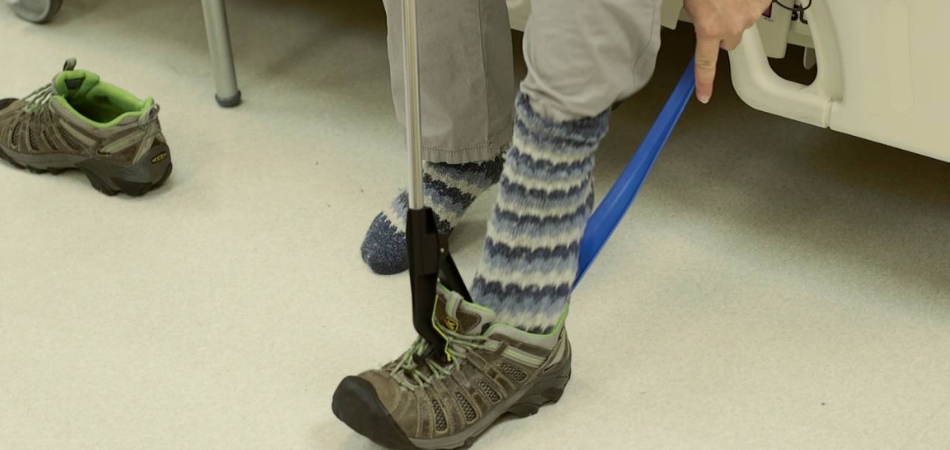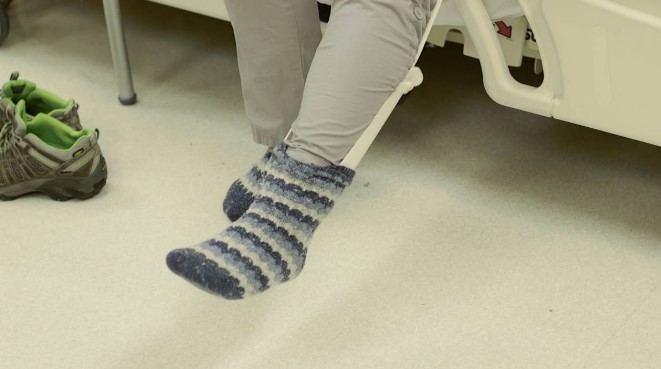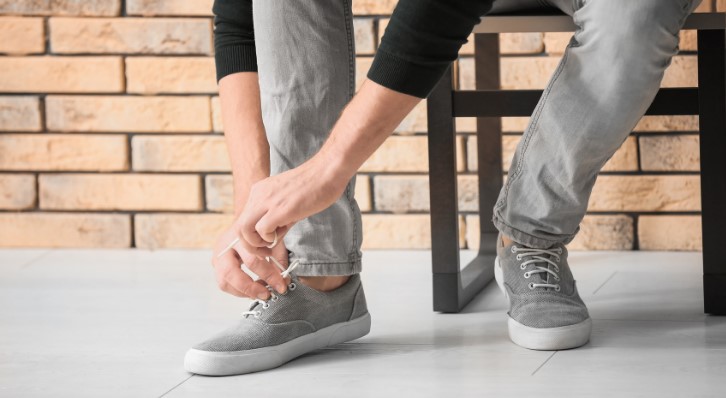How long after hip replacement can I tie my shoes? Usually, it takes about 6 to 16 weeks for tissues to heal considerably. Most surgeons would advise patients to avoid bending until after this period.
Certain factors are responsible for the period Hip replacement patients will have to wait before they can tie their shoes. One of the most prominent ones is the type of surgery. Primarily, there are two types of hip replacement surgery. These include traditional hip replacement surgery and minimally invasive hip replacement surgery.
But if you’re asking, how long after hip replacement can I tie my shoes? It depends on the type of surgery you underwent. The minimally invasive hip surgery usually takes a shorter period for the affected area to heal completely. Conversely, traditional hip surgery can take about 6 to 16 weeks for the tissues around the hip region to heal significantly. So, it’s advisable to wait for this period to be over before attempting to tie your shoes.
As you continue in this article, you’ll discover more. Furthermore, we’ve discussed the types of shoes suitable for wear during your healing process and more. So, keep reading.
Key Takeaways:
- After a hip replacement surgery, it’s important to tie your shoes loosely for lase-up shoes. This is so that your feet can easily slip in and out of them. Furthermore, employing a reacher and a shoehorn can help ease the wearing process.
- The best shoes after hip surgery are those with low, wide heels. Also, you can consider getting shoes with good shock absorption.
- Regular hip bending after hip replacement surgery usually occurs after the first 12 weeks of recovery. Before this time, most orthopedic surgeons would advise patients to avoid bending their hips beyond 70º to 90º
- Typically, it takes about 6 to 16 weeks for tissues to heal considerably. Most surgeons would advise patients to avoid bending until after this period.
How Long After Hip Replacement Can I Tie My Shoes?
Generally, it takes about 6 to 16 weeks for patients who just underwent hip surgery to be able to bend. However, the surgery healing process depends on the kind of hip replacement performed. This healing period is relative to traditional hip replacement surgery. It’s quite different in cases of minimally invasive hip surgery, as this takes a shorter recovery time. While this is true, there are certain patients can do to improve their recovery. By “improve their recovery,” we mean shortening the period it’ll take for total wellness.

Furthermore, when it comes to traditional hip replacement, it is okay to think that the surgery process is risky enough. However, you should know that there’s another risky aspect to this practice: the recovery period. Thankfully, there are necessary steps to ensure long-term health after such orthopedic surgery.
Let’s dive right into these steps in detail below!
1. Observe Your Weight and Diet
Did you know that you can stress a newly inserted hip prosthesis with excess weight? Usually, this causes wear, which results in additional complications.
You can increase the life span of the prosthesis simply by maintaining a good diet and body weight. In addition to the life span of the prosthesis, it also helps to improve the recovery process. Maintaining a good diet and body weight comes before and after the hip surgery.
2. Engage In Healthy Exercise Practices
It’s possible to walk on the same day you underwent hip replacement surgery. For some others, after the first 6 weeks, they can perform their regular activities. Once this becomes feasible, it’s important to include healthy exercises in your daily routine to ensure a healthy recovery.
Furthermore, some activities are recommended during this healing process. Some of these are gradually progressive walking and household tasks like climbing stairs, standing, and sitting.
Moreover, exercises aid blood flow, which helps to prevent blood clotting. Some of these exercises may include:
- Squeezing the thigh and calves regularly
- Engage in walking with or without a supportive device like a cane or walker
- Engage in full-range leg motion exercises
3. Make Your Household Properties Easy To Access
It won’t be so easy to perform the usual household routine after hip replacement surgery. As such, it is vital to modify your home settings. This implies putting the things you’ll need in places you can easily access them.
Furthermore, you can talk with friends, family members, or caretakers who will always be there to support you. Such support will cover things like cooking, running errands, and bathing.
It is essential to keep these guidelines in mind before and after your hip replacement surgery. With the necessary precautions and intentional effort, you can help yourself to get a successful hip surgery recovery.
When Can I Bend To Put Socks On After Hip Replacement?
Regular bending of the hip after hip replacement surgery usually occurs after the first 12 weeks of recovery. Before this time, most orthopedic surgeons would advise patients to avoid bending their hips beyond 70º to 90º. Also, it’s not advisable to cross the legs or ankles during the initial stage of hip recovery.

When it comes to hip replacement recovery, there are certain actions you need to avoid. Whether or not you just underwent hip surgery, it’s important to know what to face in the future. Depending on your lifestyle, the type of hip surgery, etc., your actions will not remain the same as others within a given period.
Furthermore, your surgeon will give you the necessary information and precautions to take during your healing process. Here are some of the tips amongst the list of information and instructions you may receive from your surgeon.
1. Avoid Crossing Your Legs
Whether or not you’re crossing the active leg over the non-active one, always know that this action is highly discouraged. Most orthopedic surgeons usually advise patients to abstain from crossing their legs after the first few weeks of hip surgery. This is because performing this action could result in hip joint dislocation.
2. Do Not Bend the Waist Beyond 90º
Bending the hip beyond 90 degrees can occur on different occasions. These include an attempt to put socks on, sit on a low chair, tie your shoes, etc. Activities such as these can as well result in a dislocated hip.
3. Pay Attention to the Position of Your Knees
Just as it is with bending the hip beyond 90 degrees, the same applies here. You must pay attention to the position of your knees with respect to the hip. This refers to how far you can raise your knees. It’s not advisable to lift them above the hip’s position, as this could also result in a dislocated hip.
4. Do Not Twist the Hip
This is quite easy to understand. As much as possible, always keep the hip and chest positions facing the same direction.
5. Drive According To Your Doctor’s Prescription
Driving after hip replacement surgery differs for every individual. It only takes a couple of weeks for some patients to get back on the road in their cars. For some others, it just takes a longer period to perform a similar action. As such, you may need to discuss this with your surgeon. He’s in the best position to tell when it’s safe to get on the road while maintaining the healing process.
6. Keep Your Feet Facing the Direction of the Hip
Another vital tip to bear in mind is the position of the feet and toes. Don’t rotate them too far outward or inward. Always ensure they’re facing the direction of the hip. This position is important whether or not you’re sitting, standing, lying down, or even walking.
7. Don’t Force the Healing Process
It can be really tempting to get back to normal activities after leaving the hospital bed. However, this is not something you want to do to the detriment of your wellness. In this case, you can opt to stay in a good nursing facility. You can properly enhance your healing process through the right rehabilitative care.
8. Try To Get Up and Move Around Sometimes
This action might seem pretty difficult at the initial stage. But don’t worry, it’s also a way to prevent blood clotting after the surgery. Moreover, preventing blood clotting aids the healing process. To this effect, it’s vital to get up and move around sometimes or as directed by your physical therapist.
What Type Of Shoes Should I Wear After Hip Surgery?
If you just underwent hip surgery, the best shoes are those with low, wide heels. Also, you can consider getting shoes with good shock absorption. Some good examples of these shoes are tennis shoes and the S. A. S. brand. For dress shoes, ensure they have wide heels that are not beyond 2 inches long.

Wearing higher heel shoes can interfere with the forces responsible for bearing weight in the joints. This tends to cause wear and pain around the joints. Also, there are running shoes for sciatica suitable for hip replacement patients who are yet to recover.
How to Tie Shoes after Hip Replacement?
After a hip replacement surgery, it’s important to tie your shoes loosely for lase-up shoes. This is so that you can easily slip your feet in and out of them. Furthermore, employing a reacher and a shoehorn can help ease the wearing process.
Let’s address this procedure step by step for better comprehension.
- Tie the laces of the shoes loosely while sitting upright on a chair or bed. This is essential to let your feet slip easily into the shoes.
- With a reacher, hold the tongue of your shoe.
- Using a long-handled shoehorn, hold its heel.
- Now, simply slip your foot easily into the shoe.
Usually, if you can see your ankle or foot while slipping your foot in and out of the shoe, then you’re breaking the hip precautions. This may not be very clear to you without a . Moreover, it’s important to have someone nearby, especially at the initial stage of recovery.
Is It Possible To Run After Hip Replacement Surgery?
When it comes to running after hip replacement surgery, talking with an orthopedic surgeon is necessary. This is because there are varying opinions concerning this aspect of hip surgery. Certain physicians would claim that it’s not ideal for engaging in running after hip replacement surgery. On the other hand, some others would say it’s possible to run after the procedure. They would add that this depends on the bone quality of the patient and the type of material used.

Due to this fact, it’s quite crucial to discuss with your doctor to know when it’s safe to engage in running. There’s no need to rush. You can take as much time as you need. Moreover, we’ve provided you with some important techniques to help you resume this activity safely. Some of which involve smooth motions in your procedure.
Adding smooth motions to your procedure implies starting slow and increasing the pace with time. You can start by walking; afterward, you can proceed to power walking. Once you’re comfortable with this, you can move to jog. But ensure you’re doing this on a plain surface to avoid tripping. If you start feeling pain or uncomfortable at some point, simply slow down or quit. Running can come in later after full recovery.
As you resume your running routine, always put these techniques in mind:
- Do proper warm-ups
- Stretch your arms, hips, back, and legs
- Begin at a slow pace and gradually proceed to longer runs
- Always relax after a running session and stretch the muscles. This will help prevent any more injury to the hip.
- Avoid jarring motions, as they could negatively affect the new hip.
In addition, following the advice of your physical therapist is the most important thing here. He’s in the best position to schedule an ideal program. The program should be intended to keep you safe as you carry out your running regimen. Also, he can include different ways to integrate diverse lifestyles to ensure the hip stays free of problems.
Final Words
To conclude this article, we would like to remind you again that it takes about 6 to 16 weeks before the hip replacement-recovery process is considered total. Patients should not bend their hips beyond 60 to 90 degrees during this period. So, how long after hip replacement can I tie my shoes? Well, this depends on your doctor’s prescription. However, in most cases, patients will have to wait until after those weeks before they can bend the hips.
The major factor that determines how long the hip surgery recovery process will take is the type of hip replacement. The minimally invasive hip surgery, where the recovery process doesn’t take long. Conversely, there’s traditional hip replacement surgery. This full hip replacement procedure takes weeks for the tissues to heal considerably.
